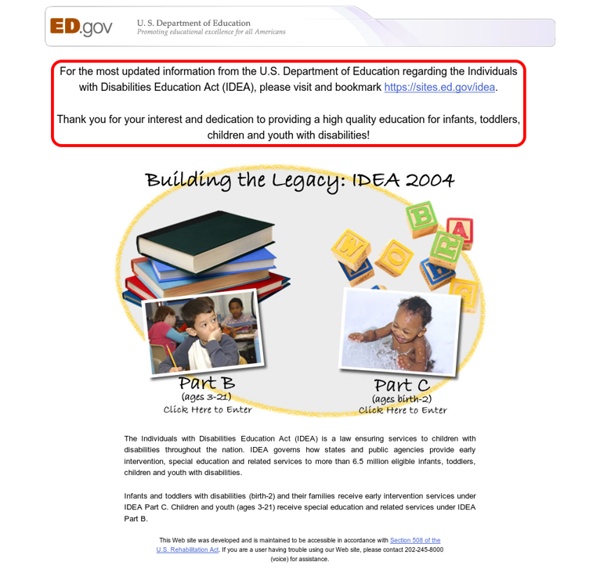Professional Positions & Policies
Preparation and Use of Personnel[1] Chapter 02 Professional Standards, Rights, and Responsibilities CEC Resolutions and Positions
Protecting Students With Disabilities
Frequently Asked Questions About Section 504 and the Education of Children with Disabilities Introduction | Interrelationship of IDEA and Section 504 | Protected Students | Evaluation | Placement | Procedural Safeguards | Terminology This document is a revised version of a document originally developed by the Chicago Office of the Office for Civil Rights (OCR) in the U.S. Department of Education (ED) to clarify the requirements of Section 504 of the Rehabilitation Act of 1973, as amended (Section 504) in the area of public elementary and secondary education.
Classroom Resources
Home › Classroom Resources Grades K – 12 | Student Interactive Venn Diagram This interactive tool allows students to create Venn diagrams that contain two or three overlapping circles, enabling them to organize their information logically. Grades 3 – 12 | Mobile App
No Child Left Behind - ED.gov
Information on No Child Left Behind, including the Act and policy, and the Obama Administration's blueprint for reauthorizing the Elementary and Secondary Education Act. ESEA Page Reauthorizing the Elementary and Secondary Education Act ESEA Flexibility Waivers from No Child Left Behind ESEA Blueprint for Reform The Obama administration's blueprint to ESEA reauthorization NCLB Legislation Public Law PL 107-110, the No Child Left Behind Act of 2001
Child Progress Assessment Tools
How Does HighScope Assess Children's Progress? HighScope's research-validated child assessment tools serve multiple purposes. They are designed to: Look at meaningful educational outcomes Gather information in ways that are natural and comfortable for children and adults Provide accurate data that can be used for individual child planning and policy-level decision making And, because HighScope is an advocate for sound early childhood practices in general, our assessment tools are designed for use by non-HighScope programs as well as by those that do use the HighScope Curriculum.
Breakthrough Study Reveals Biological Basis for Sensory Processing Disorders in Kids
In a groundbreaking new study from UC San Francisco, researchers have found that children affected with SPD have quantifiable differences in brain structure, for the first time showing a biological basis for the disease that sets it apart from other neurodevelopmental disorders. One of the reasons SPD has been overlooked until now is that it often occurs in children who also have ADHD or autism, and the disorders have not been listed in the Diagnostic and Statistical Manual used by psychiatrists and psychologists. “Until now, SPD hasn’t had a known biological underpinning,” said senior author Pratik Mukherjee, MD, PhD, a professor of radiology and biomedical imaging and bioengineering at UCSF. “Our findings point the way to establishing a biological basis for the disease that can be easily measured and used as a diagnostic tool,” Mukherjee said. (The image above shows areas of the brain that can be affected by sensory processing disorders. ‘Out of Sync’ Kids
Plan: Multiple products to demonstrate understanding and knowledge
Create an assignment or assessment with multiple products Students use their content knowledge and a variety of skills to create products or performances. These products or performances can be used to assess student growth and strengths. On the next page is a brainstorm of possible products or performances grouped by the communication method primarily used for the task.
ATTO: Assessing AT Student Need: SETT Framework
Knowing what to address in an AT Assessment is similar to other assessments that are done. We'd like to share with you a helpful framework for team-based AT assessment. It's called the SETT framework and is a guideline for gathering data to make effective AT decisions. You always begin by collecting information about the student. S for the Student E for the Environment
FSSA: Forms
IN.gov - Skip Navigation Note: This message is displayed if (1) your browser is not standards-compliant or (2) you have you disabled CSS. Read our Policies for more information.



